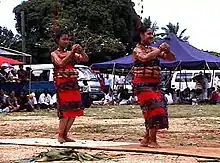The ula (dance) is an ancient Tongan group dance, already reported by early European navigators like captain Cook. It is also known as fahaʻi-ula (split dance), which may be degenerated to fahaʻiula. Traditionally it is performed after an ʻotuhaka.[1] It is still danced nowadays, although less popular than its descendant the tauʻolunga.
Lyrics


The oldest parts seem to be from Samoan origin:
ʻOiau, siʻa langi ula; ʻi ʻiē fai mai siʻa tauʻolunga. ʻio! Tulopa he ʻiau moe; ʻio ē! vasaleva ʻiau moe; ʻio! Sina vai tava ʻā ē he ʻiē, ʻā ē. Sina vai tafe loʻu lonā. ʻio, ʻio, he loʻu lonā. Tunotuna ʻoe Ale-le-sā, manuia ʻoe saualuma. Laulau tuʻi Vaea ē, Vaea lau mānaʻia.
These parts are from the beginning of the 20th century:
Tonga, Tonga ē, tulituli faiva, he tuli faiva ē peʻi kau muʻa peʻi kau mai ke tau kalofi kuo tau e langi tulituli faiva, he tuli faiva ē. Tonga, Tonga ē, tulituli faiva, he tuli faiva ē ko e faiva ni ko hoto kakala ʻo lau taʻanga pea fola haka tulituli faiva, he tuli faiva ē. Tonga, Tonga ē, tulituli faiva, he tuli faiva ē kuo ke meaʻi siʻoto founga fiemālie tuku ke u ula tulituli faiva, he tuli faiva ē.
And then there are still more variants.
Execution
The name split dance comes from the habit that the performers split up in two (or more) groups, one entering the stage from the left, the other from the right,[2] until the two meet in the centre and merge into one or more rows. The performers are always girls, it is rare that boys will join.
The dance movements are in essence very simple and limited. Most of the work, making supple, beautiful postures, is done by the hands and the head. The body remains quite stiff, and except for an occasional step or a kneeling, the legs are not much used either.
The dress of the girls is like that of the tauʻolunga, although the red dress is here most popular.
References
- ↑ Firitia Velt (1991). "The ʻotuhaka among the other Tongan dances". ʻOtuhaka, a Tongan Dance (PDF). Nukuʻalofa: Atensi Institute. p. 6. Retrieved 18 January 2022.
- ↑ Kaeppler, Adrienne Lois (1967). THE STRUCTURE OF TONGAN DANCE (PDF) (PhD). University of Hawaii. p. 248. Retrieved 18 January 2022.